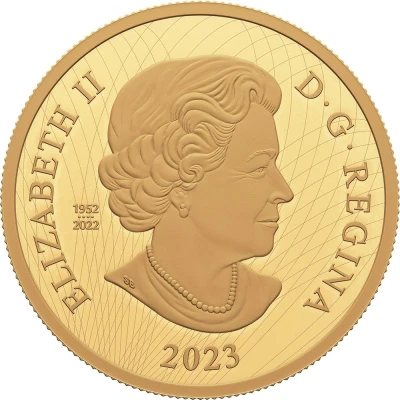


© Power Coin
250 Dollars In the name of Elizabeth II; The St. Edward’s Crown
2023 year| Gold (.9999) | 60.08 g | 38 mm |
| Issuer | Canada |
|---|---|
| King | Charles III (2022-date) |
| Type | Non-circulating coin |
| Year | 2023 |
| Value | 250 Dollars 250 CAD = USD 185 |
| Currency | Dollar (1858-date) |
| Composition | Gold (.9999) |
| Weight | 60.08 g |
| Diameter | 38 mm |
| Shape | Round |
| Technique | Milled (inlay of white sapphires, emeralds, ruby and aquamarine) |
| Orientation | Medal alignment ↑↑ |
| Updated | 2024-10-04 |
| Numista | N#365985 |
|---|---|
| Rarity index | 100% |
Reverse
Representation of the front cross pattée from the St. Edward’s Crown, engraved heraldic cross studded with nine white sapphires, two emeralds, a ruby and one aquamarine, bordered by rows of beads and inscription of denomination.
Script: Latin
Lettering:
CANADA
250 DOLLARS
Edge
Serrated
Comment
AboutIt is the revered symbol of royal authority, history and tradition. The centuries-old St. Edward’s Crown is only worn once in a monarch’s reign and only at the very moment of crowning—the moment when the historic headpiece is reverently placed upon the new sovereign’s head, marking the culmination of accession. The centrepiece of the British Crown Jewels and royal regalia, the all-gold coronation crown is easily recognized by the crosses pattée that inspired this 99.99% pure gold coin’s reverse, where the engraved cross is similarly adorned with an array of gemstones.
St. Edward's Crown
The most hallowed of all the British Crown Jewels and royal regalia, the St. Edward’s Crown is only used on the monarch’s coronation day. It was commissioned for the coronation of King Charles II in 1661 as a replacement for the original crown, which dated back to King Edward the Confessor (hence the name) but was melted down by parliamentarians in 1649. The “new” St. Edward’s Crown is composed of a solid gold frame set with 444 precious and semi-precious stones, including amethysts, aquamarines, garnet, peridot, rubies, topazes, tourmalines and sapphires. Similar to the medieval crown that inspired its design, the St. Edward’s Crown is distinguished by four crosses pattée (like the one featured on your coin), four fleurs-de-lis and gold bead-adorned arches that surround the ermine-trimmed velvet cap.
Design
The coin’s reverse features a representation of the front cross pattée from St. Edward’s Crown, the centuries-old coronation crown and the centrepiece of the British Crown Jewels. Bordered by a row of beads inspired by the crown, the engraved heraldic cross is studded with nine white sapphires, two emeralds, a ruby and one aquamarine.
The coin’s obverse features a curved line pattern and the effigy of Queen Elizabeth II by Susanna Blunt. The obverse also bears a special marking that includes four pearls symbolizing the four effigies that have graced Canadian coins and the double date of her reign.
Did you know?
Heavy is the head that wears this crown, which weighs 2.23 kilograms (almost five pounds). From 1702 until 1911, the St. Edward’s Crown was simply carried during each coronation procession and placed on the altar in Westminster Abbey for the ceremony, but never actually worn by the new monarch—it was thought to be too heavy. That changed in 1911, when King George V was crowned with the St. Edward’s Crown, and it has crowned all British monarchs since.
When the St. Edward’s Crown was commissioned in 1661, the cost of buying the gems was deemed too prohibitive; instead, the jewels were rented for each coronation and replaced with imitation stones for public viewing. Its jewels were set permanently in 1911.
Packaging
The coin is individually encapsulated and presented in a premium Royal Canadian Mint-branded wooden case with a black beauty box, with an additional certificate of authenticity for its gemstones.